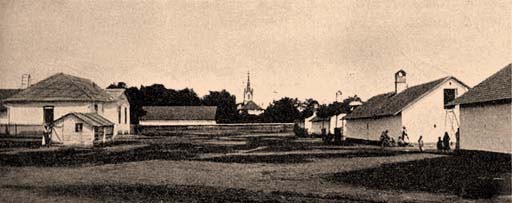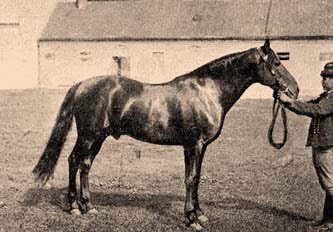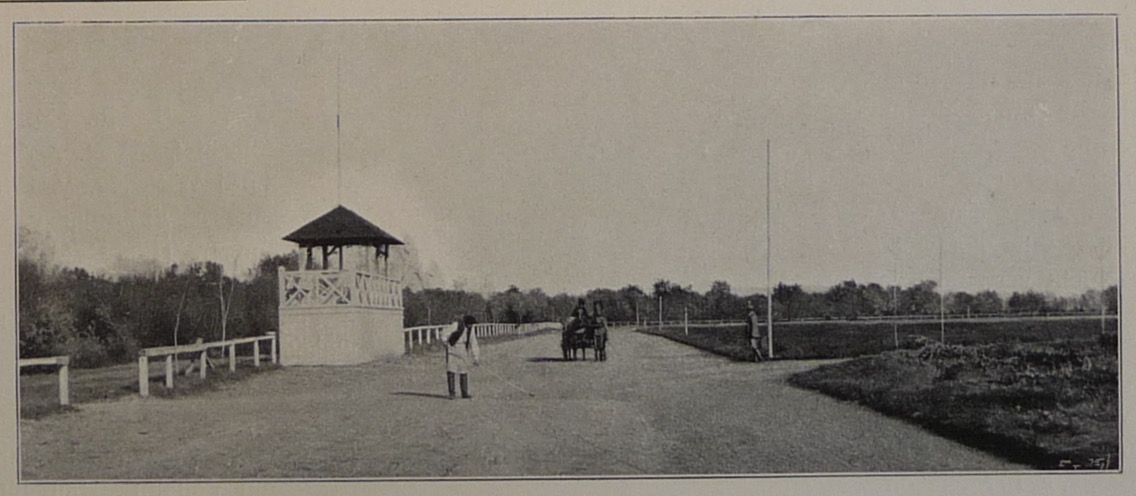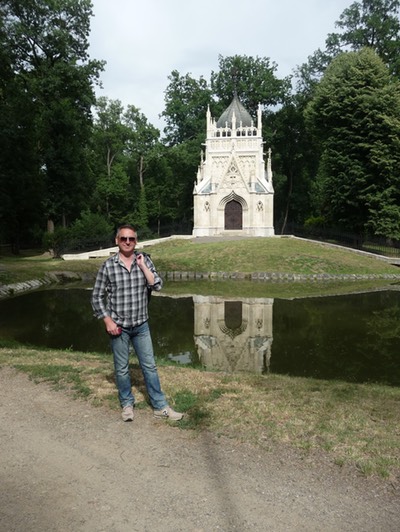A Trip by Nikolaus Matzka and Gabriel Petrík
Our route to some places of the beginning of Trotting. From Google Maps
Day 3
Királytelek, Hungary

On the property of count Alajos Dessewffy (1851-1904) in Királytelek was located one of the biggest breeding facilities in the Monarchy. It had a longer history connected to the Arabian bred horses and in the 2nd half of the 19th century the farm refocused their interests towards Hungarian coach horses (jukkers) and then later toward trotters. In 1882 he purchased for his stud the American stallion Cupid, recent European recorder and the owner of the first official mile rate under 2 minutes 25 seconds in Europe. In 1889 the Count got his second sire, Italian Carignano with an American origin. Dr. József Vecseklőy in his book "The Hungarian Trotter" provided an interesting comparison of the ten best kilometer rates for different “generation” of the horses:
– the original half-bred material
of the stud: 2:04,6 (min. 1:59, max. 2:13,5)
– the offspring of the half-bred
mares paired with Cupid: 1:51,5 (min. 1:39,1, max. 2:00,8)
– the offspring of the Cupid’s
daughters paired with Carignano: 1:30,5 (min. 1:27,9, max. 1:32)

In 1901 the owner purchased the American sire Deck Miller, who was the creator of the further success of the stud. But Count Dessewffy could not see it, he died in 1904. After his death the farm operated under the supervision of his brother Dénes, but many horses have been sold and the production was gradually lowered until the complete cancellation during the 1st World War. Families of the original half-bred mares gave in the field of breeding a lot of good trotters and for example the maternal line of Baka is also going back to Királytelek. In 1891 born Mérges C. (Carignano – Mérges II.) was the winner of Anton Poschacher-Preis in 1894, in 1903 born Rabló P. (Deck Miller – Sármány G.) won the Austria-Preis in 1907. At the place of the former stud is a privately owned agricultural company so the property is not open for public.
Vencsellő, Hungary
The second big trotting stud farm operated by
Dessewffy family was in Vencsellő (today Gávavencsellő) and was owned by Count
Miklós Dessewffy. At the beginning of the 20th Century there have been more than fifty trotters! The first stallion there was Késő born in
Királytelek, later he was followed by American Robbie P. and mostly Gayton
responsible for the most significant achievements of the stud. Its founder died
in 1918, but the stud continued to produce trotters also in the third decade of
the 20th Century when the Derby-winner Ibikus was the stallion
there. In the classic and more important races were successful Hát-ha (winner
of the Preis der Stadt Wien, Ernst Rudiger-Starhemberg-Preis and the Preis der
Stadt Baden), Puszta-gyöngye (Hungária Díj winner in 1920), Éva lánya (Nemzeti
Díj winner in 1923), Csalfa (Vindobona-Handiacp winner in 1915) and others. The
historical building was recently used as a night club and it is currently in
bad shape (see below).
Vencsellö, Hungary. Foto: Nikolaus Matzka
Borša, Slovakia
A very interesting view provided the book "A Magyar Ügető" when looking at the history of the harness racing on the territory of current Slovakia. In 1863 we could find two different mentions of the trotting races in geographically remote locations. In the city of Šurany was the first harness racing with written evidence in the end of July. In early November the same year the local association of Zemplén County organized a race meeting which included also one harness competition for two-horse carts. This event was probably overlooked by Dr. Vecseklőy, because it is not mentioned in the book, but its results were published in the journal used by him as a source for his work. Racing took place in today’s Borša, near the castle which is the birthplace of Francis II. Rákóczi (1676-1735). Among the three participants on the distance of one and a half English miles the fastest couple was the pair of chestnut horses of Ödön Lónyai with winning time 4 minutes 40 seconds (kilometer rate 1:56,0).
Borša, Slovakia. Foto: Nikolaus Matzka
Čerhov, Slovakia
Property in Čerhov was a trotting stud farm smaller in a size, but great in terms of his importance, owned by Count Géza Sennyey (1870-1934). This is the place where European record holder Baka was born. Count Sennyey started the stud in the last decade of the 19th Century. American sire Juan Bryant was the first trotting sire there, later he was followed by other American sires (Dirego, Mount Morris, Bravado). In the first years of the 20th Century the stud increased the number of the mares from the above mentioned stud of Count Alajos Dessewffy in Királytelek. Among the new acquisitions was also Páva F., the grandmother of Baka. But he was not the only successful spring of the stud. Here were born e.g. Tedd meg (winner of Derby-Trial in 1912 and Hungária Díj in 1913 in Budapest), Máglya (winner of the Austria-Preis in 1920), Vitality (holder of the absolute Hungarian record of 1:22,3 from 1919) and others.
At the site of the Sennyey property now stands an elementary school and kindergarten (above) and at the place of the former stud were built houses. We had a great help when discovering the objects in Čerhov because we met a local senior citizen, who played as a child with the grandson of Count Sennyey, József, later working as a pilot in Venezuela.
Gabriel Petrik and a senior citizen of Čerhov, Slovakia. He is a winemaker out of his own grapes… This is the world famous winegrowing area of the sweet Tokaj wines. Fotos: Nikolaus Matzka
Trebišov, Slovakia
The dominant object of the City Park in Trebišov is the mausoleum of Count Gyula Andrássy (1823-1890). He was an important personality of monarchical political life and in between the years 1867-1871 he was the Prime minister of Hungary. He devoted himself to the politics at a young age, he served as Member of Parliament for County of Zemplén (in today’s Eastern Slovakia). After the Hungarian Revolution in 1848 he had to go into exile where he spent nine years. After his return to the homeland he started again his political career but also was active in other fields of life in the Zemplén County. The reason for our stop was the fact that Count Andrássy was one of the organizers of the horseracing meetings in Borša mentioned above.
Day 4
Tata, Hungary
One of the most important personalities of the monarchical trotting scene was Count Nicolaus Esterházy (1839-1897). He was very active both in gallop and trotting sport, his name was in the 1880’s Hungarian Kingdom equal with the trotting itself. He was a breeder and owner and at younger age he was also active as a steeplechase jockey (e. g. winner of the first Grosse Wiener Steeplechase in 1868 with Cure All). He was a member of Austrian Jockey-Club, he played a role during the development of the racecourse Freudenau in Vienna and at his property in Tata he built a big training and racing course after the model of Newmarket. With his gallop horses he won a several important races, among others he won twice the Austrian Derby and three times the Velka pardubicka steeplechase.
In 1877 he established in Budapest the “Association for the Improvement of the Horse Breeding” which was later responsible for the organization of the regular trotting meetings in the capital of the Hungarian Kingdom. The association operated between 1883 and 1891 when it terminated it´s activity due to the lack of interest. During this era in Budapest, Count Esterházy was on the top of the rankings of the owner championships, he won the Hungarian Trotting Derby four times (1884 – Andal, 1887 – Regedal, 1889 – Ajándék, 1891 – Barbarossa). With first three mentioned trotters he also won the Austrian Trotting Derby. All of them were bred by their owner in Tata and some of them had thoroughbred origin. Count Esterházy experimented in the field of breeding the fast trotting horses when he used as a stallion the thoroughbred Waisenknabe.
A large share on their success belonged to his trainer and driver Carl Hutschenreiter. He was born around 1845 in Bavaria and started to work as a trotting trainer in Tata around 1880. During his career he won the Hungarian Derby five times as a driver (1884 – Andal, 1885 – Dami, 1886 – Rastelbinder, 1887 – Regedal, 1889 - Ajándék) and six times as a trainer (the mentioned horses & Barbarossa in 1891). With Andal, Regedal and Ajándék he got the monarchical Derby-double. Count Esterházy established a separated facility for Hutschenreiter's work. His training facilities including a training racecourse were located near the later champagne factory of the Esterházy family. Today it is operating in private ownership again as a champagne producing facility. We had luck during our visit, because the current owner gave us a sightseeing tour of this glorious property.
Count Esterházy ended his trotting activities in the beginning of the 1890’s and started to support the local theatre. He died on 7th May 1897 at the age of 58, just two days after the death of his trainer Carl Hutschenreiter.
Abrahám, Slovakia

Another member of the well-known Esterházy family was involved in the trotting horse breeding and racing. Count Carl Esterházy (1847 - 1919) had his stud farm in today’s Abrahám in Slovakia. It started its trotting production in the last decade of the 19th Century, the later stallions were there mostly used American horses, like Fern Wilkes, Almont Dictator and Tonquin. The facility in Abrahám was well equipped and offered a training course. The mansion itself was also very well furnished and decorated and also included a painting studio. The property was later sold by the Esterházy family and after the WW2 when it was nationalized it served many purposes. Nowadays it is ruined, in it´s last era there was a sanatorium for kids with metabolic diseases. On the satellite image on the Google Maps there is an area which reminds the shape of the trotting track …
Text by Gabriel Petrik.
Nikolaus Matzka is Editor in Chief of the Austrian trotting racing programs Krieau Aktuell and Baden Aktuell and Editor of the Trotting Websites www.breedingtrotters.com and www.trabrennzucht.at. He lives in Vienna, Austria.
Gabriel Petrík is trotting fan, working as an IT-Specialist and living with his family in Bratislava, Slovakia. He publishes the website www.trotdb.info including a historic Austrian-Hungarian Studbook (see also here).
2016_12
